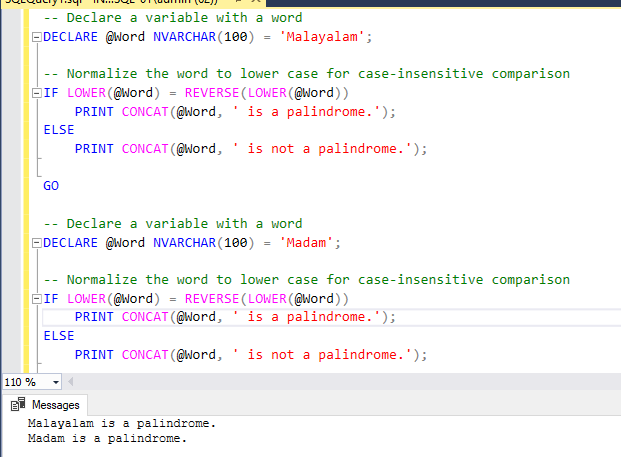A palindromic string is a word or phrase that reads the same backward as forward. They’re symmetrical, self-reflecting, and satisfyingly logical — the mirror images of language. Palindromes are more than linguistic party tricks; they’re found in poetry, computer science, data validation, and even in natural language quirks.
Palindromes aren’t just linguistic curiosities — they play a surprisingly important role in the real world across various fields, including:
- Language Games: Crosswords, word puzzles, and AI language processing.
- Data Quality Checks: Detecting reversible patterns in data.
- Security: In encoded strings and symmetric cryptographic design.
- NLP & Pattern Recognition: Useful in machine learning feature extraction.
- Names & Brands: Palindromic names are memorable — think Malayalam or Radar.
How SQL Identifies Palindromes?
To identify whether a string is a palindrome in SQL, we simply compare it with its reversed form using the REVERSE() function. Below is an example
-- Declare a variable with a word
DECLARE @Word NVARCHAR(100) = 'Malayalam';
-- Normalize the word to lower case for case-insensitive comparison
IF LOWER(@Word) = REVERSE(LOWER(@Word))
PRINT CONCAT(@Word, ' is a palindrome.');
ELSE
PRINT CONCAT(@Word, ' is not a palindrome.');
GO
-- Declare a variable with a word
DECLARE @Word NVARCHAR(100) = 'Madam';
-- Normalize the word to lower case for case-insensitive comparison
IF LOWER(@Word) = REVERSE(LOWER(@Word))
PRINT CONCAT(@Word, ' is a palindrome.');
ELSE
PRINT CONCAT(@Word, ' is not a palindrome.');
GO

Conclusion:
Palindromes like Malayalam, madam, refer, level, and radar prove that beauty exists in data symmetry. With just a single function (REVERSE()), T-SQL gives you a fun and functional way to find hidden patterns in plain sight.